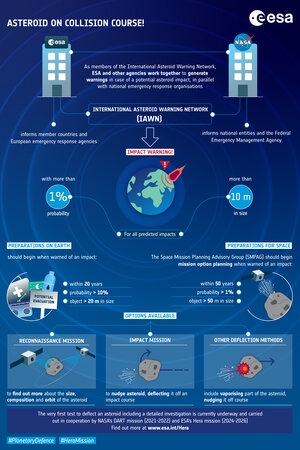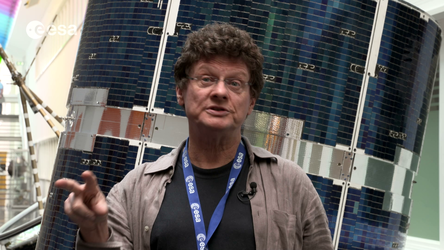Accept all cookies Accept only essential cookies See our Cookie Notice

About ESA
The European Space Agency (ESA) is Europe’s gateway to space. Its mission is to shape the development of Europe’s space capability and ensure that investment in space continues to deliver benefits to the citizens of Europe and the world.
Highlights
ESA - United space in Europe
This is ESA ESA facts Member States & Cooperating States Funding Director General Top management For Member State Delegations European vision European Space Policy ESA & EU Space Councils Responsibility & Sustainability Annual Report Calendar of meetings Corporate newsEstablishments & sites
ESA Headquarters ESA ESTEC ESA ESOC ESA ESRIN ESA EAC ESA ESAC Europe's Spaceport ESA ESEC ESA ECSAT Brussels Office Washington OfficeWorking with ESA
Business with ESA ESA Commercialisation Gateway Law at ESA Careers Cyber resilience at ESA IT at ESA Newsroom Partnerships Merchandising Licence Education Open Space Innovation Platform Integrity and Reporting Administrative Tribunal Health and SafetyMore about ESA
History ESA Historical Archives Exhibitions Publications Art & Culture ESA Merchandise Kids Diversity ESA Brand CentreLatest
Space in Member States
Find out more about space activities in our 23 Member States, and understand how ESA works together with their national agencies, institutions and organisations.
Science & Exploration
Exploring our Solar System and unlocking the secrets of the Universe
Go to topicAstronauts
Missions
Juice Euclid Webb Solar Orbiter BepiColombo Gaia ExoMars Cheops Exoplanet missions More missionsActivities
International Space Station Orion service module Gateway Concordia Caves & Pangaea BenefitsLatest
Space Safety
Protecting life and infrastructure on Earth and in orbit
Go to topicAsteroids
Asteroids and Planetary Defence Asteroid danger explained Flyeye telescope: asteroid detection Hera mission: asteroid deflection Near-Earth Object Coordination CentreSpace junk
About space debris Space debris by the numbers Space Environment Report In space refuelling, refurbishing and removingSafety from space
Clean Space ecodesign Zero Debris Technologies Space for Earth Supporting Sustainable DevelopmentSpace weather
Space weather and its hazards ESA Vigil: providing solar warning ESA Space Weather Service NetworkLatest
Applications
Using space to benefit citizens and meet future challenges on Earth
Go to topicObserving the Earth
Observing the Earth Future EO Copernicus Meteorology Space for our climate Satellite missionsCommercialisation
ESA Commercialisation Gateway Open Space Innovation Platform Business Incubation ESA Space SolutionsLatest
Enabling & Support
Making space accessible and developing the technologies for the future
Go to topicBuilding missions
Space Engineering and Technology Test centre Laboratories Concurrent Design Facility Preparing for the future Shaping the Future Discovery and Preparation Advanced Concepts TeamSpace transportation
Space Transportation Ariane Vega Space Rider Future space transportation Boost! Europe's Spaceport Launches from Europe's Spaceport from 2012Latest

Challenge: Spot the asteroids
Thank you for liking
You have already liked this page, you can only like it once!
We know about 95% of all near-Earth objects larger than 1 km in size – the huge, mass-extinction-sized space rocks that roam the Solar System.
However, when it comes to near-Earth objects larger than 30 metres in size, only about 18 000 of an estimated 2 million have been detected so far. This is because they are very faint and only become observable as they get close to Earth.
In July this year, an unknown asteroid passed Earth at a distance of 10 million km, about 26 times the distance to the Moon. Now named 2020 OM3, it is estimated to be 40 m in size – about the diameter of the Tunguska asteroid that exploded in Siberia on 30 June 1908, flattening 2000 square kilometres of forest.
Using its 1-m telescope in Tenerife, Spain, ESA typically spends four nights per month observing 'NEO's. The focus is particularly on follow up observations – getting a better look at objects once they have been discovered, to better understand their size, orbit and chance of collision.
Once regular follow-up targets have been observed, ESA's Near-Earth Object Coordination Centre runs a search programme to look for new objects. Images are taken of certain sections of the sky, and repeated four times.
On 24 July, asteroid 2020 OM3 showed up as a faint speck of light in four images taken between 2:46 UT and 3:36 UT. During these 50 minutes it had crossed quite a significant part of the telescope's field of view, making it quite a challenge to spot.
This animation is a crop of the telescope's larger view. Nonetheless, three moving objects are visible, including 2020 OM3. The four exposures are repeated in an endless loop and tiny dots can be seen hopping in a straight line.
The challenge is to discover the moving objects:
• If you find any, send us the approximate start and end positions of each asteroid using the numbers on the horizontal and vertical axes to create coordinates.
• Bonus question: can you give us the official names of the objects that you've found?
Hint: 2020 OM3 is the fastest of all moving objects, and it’s also the faintest.
Good luck asteroid hunting!
You can download a high resolution version of the image at the top of the page or on the Near-Earth Object Coordination Centre's asteroid riddle homepage. Send your responses to neocc@ssa.esa.int before 25 September. Use as subject of your email: “Riddle #4 – solution”.
Please let us know if you would prefer not to have your name included in the list of correct replies.
-
CREDIT
ESA -
LICENCE
ESA Standard Licence

Asteroid danger explained

Mitigation: Asteroid deflection

Asteroid 2012 TC4 will fly past Earth in October 2017

Asteroid Day - ESA experts explain the nature and th…















 Germany
Germany
 Austria
Austria
 Belgium
Belgium
 Denmark
Denmark
 Spain
Spain
 Estonia
Estonia
 Finland
Finland
 France
France
 Greece
Greece
 Hungary
Hungary
 Ireland
Ireland
 Italy
Italy
 Luxembourg
Luxembourg
 Norway
Norway
 The Netherlands
The Netherlands
 Poland
Poland
 Portugal
Portugal
 Czechia
Czechia
 Romania
Romania
 United Kingdom
United Kingdom
 Slovenia
Slovenia
 Sweden
Sweden
 Switzerland
Switzerland
























